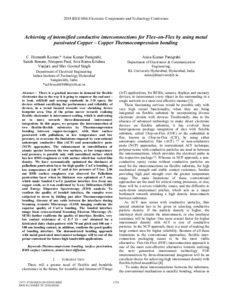C, Hemanth Kumar and Panigrahi, Asisa Kumar and Bonam, S and Paul, Nirupam and Vanjari, Siva Rama Krishna and Singh, Shiv Govind
(2018)
Achieving of Intensified Conductive Interconnections for Flex-on-Flex by Using Metal Passivated Copper – Copper Thermocompression Bonding.
In: 68th IEEE Electronic Components and Technology Conference, 29 May-1 June 2018, United States.
![[img]](http://raiithold.iith.ac.in/4420/1.hassmallThumbnailVersion/2018%20IEEE%2068th%20Electronic%20Components%20and%20Technology%20Conference_1732-1737_2018.pdf)  Preview |
|
Text
2018 IEEE 68th Electronic Components and Technology Conference_1732-1737_2018.pdf
- Published Version
Download (568kB)
| Preview
|
Abstract
There is a gradual increase in demand for flexible electronics due to the way it is going to empower the end user - to bent, roll/fold and arrange randomly in 3-D space, the devices without sacrificing the performance and reliability of devices, in a trend focused towards ever shrinking device footprint area. One of the prime mover towards realizing flexible electronics is interconnect scaling, which is motivating us to move towards three-dimensional interconnect integration. In this paper, we propose the interconnection of two flexible-flexible substrates by Thermocompression bonding between copper-to-copper, with their surface passivated with palladium, at low temperature and low pressure, to overcome the limitations imposed by conventional anisotropic conductive film (ACF) and nonconductive paste (NCP) approaches. The enhancement in interdiffusion of atomic species between the two surfaces, at low temperature and pressure, is possible only with unoxidized surface which has low RMS roughness or with surface which has varied film density. We have systematically optimized the thickness of palladium passivation layer for high quality Cu-Cu bonding, at low temperature of 140 oC and at low pressure of 5 bar. 2.06 nm RMS surface roughness was observed for Palladium passivation layer when its thickness was optimized at 5 nm, which made bonded Cu-Cu junction interface free from any copper oxide, as it was confirmed by X-ray Diffraction (XRD) and Energy Dispersive Spectroscopy (EDS) analysis. To confirm the quality of bonded interface, the samples were subjected to stress by folding just after Thermocompression bonding. Absence of any voids between the interfaces during Scanning Acoustic Microscopy (SAM) imaging confirms the superior quality of Cu-Cu bonding. The bonded interface image from cross-sectional Scanning Electron Microcopy (X-SEM) further reaffirms the quality of interface. Besides, very low contact resistance of ~2 E-7 ? - cm2 obtained for a fabricated daisy chain pattern with 70 um pitch and 100 um × 100 um bonding contact, in addition, confirms the good quality of bonding interface. The demonstrated bonding approach with metal passivated interconnect technique will be one of the prime contestant for future high bandwidth applications.
Actions (login required)
 |
View Item |


 Altmetric
Altmetric Altmetric
Altmetric